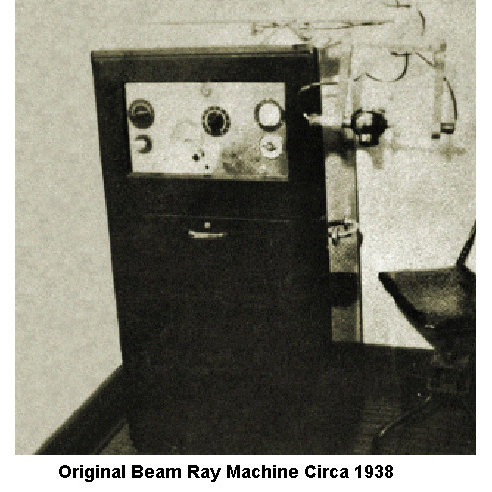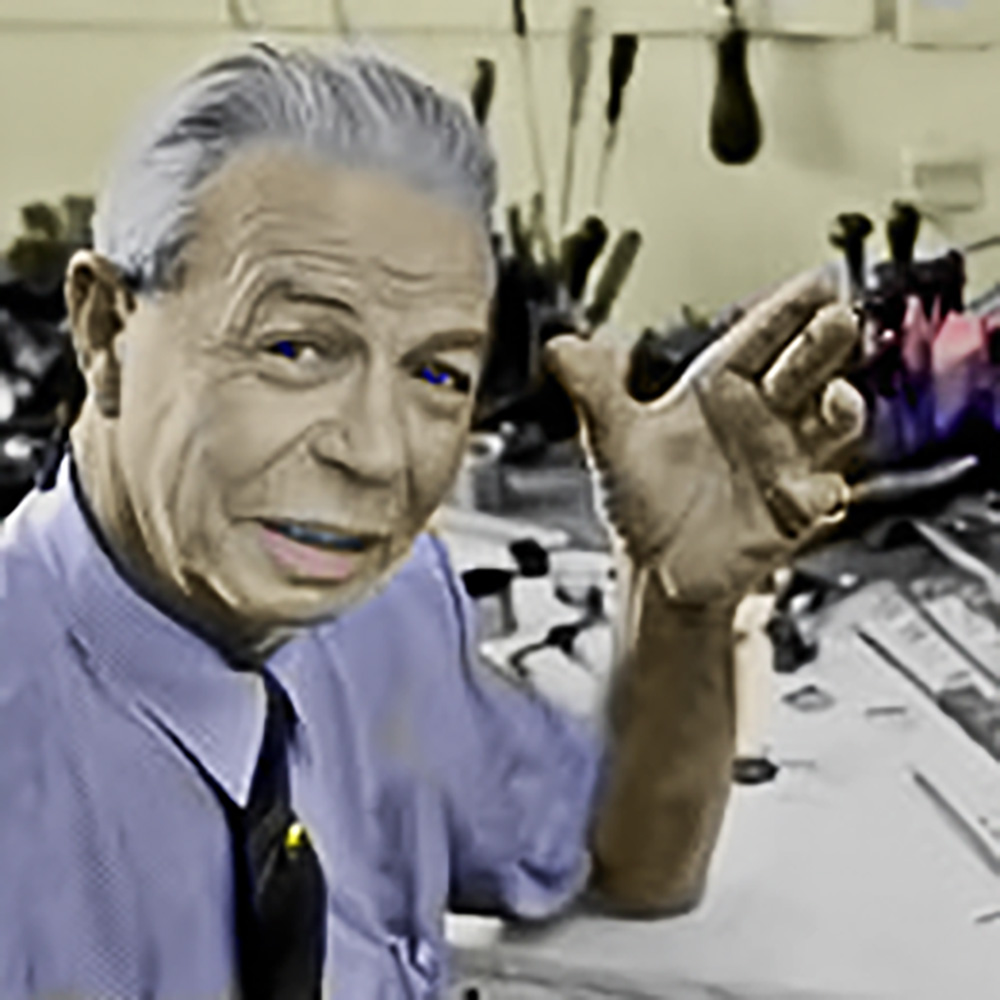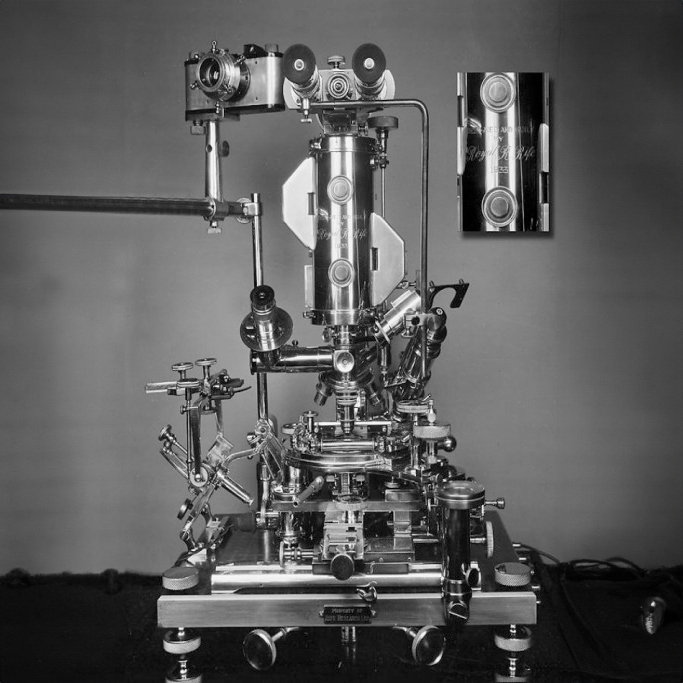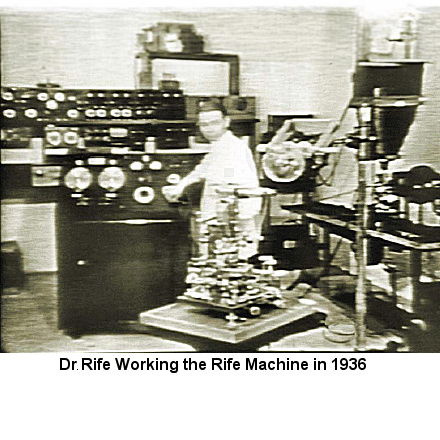
Foundation for the Rife Research:
The full story of the cancer clinic of 1934 may never be known. Rife’s records were lost when he foolishly loaned them to Dr. Arthur Yale a few years later. Yale had started his own clinic and apparently wanted to compare notes. After Rife learned that Dr. Yale was altering the Royal Rife Machine and thus failing to get results, Rife and Yale had an argument which marked a permanent separation. More disturbing is that after AMA pressure forced a law suit against the production company making the Royal Rife Machines, many of the doctors who were involved became exceedingly cautious. And after Milbank Johnson’s death, the records at the University of Southern California “mysteriously disappeared.”
Pieces of evidence do exist and while the clinical records are gone, there is sufficient documentation to know that astounding results did take place and that the Special Medical Research Committee did continue to exist. The listings under the name of Milbank Johnson in Who’s Who for 1944-45 (Johnson died October 3, 1944) include: “Professor physiology and clinical medicine, University of Southern California 1897-1901, now Chairman special medical research committee of the university.”
Suppression of the Cancer Treatment
The suppression of the successful cancer treatment first used in 1934 took place because of a unique set of factors. Among these factors were: the virtual one-man rule within the American Medical Association, scientific rivalries, institutional pride and arrogance, a power-hungry head at Memorial Sloan- Kettering determined to find his own cure for cancer even if it required squashing those with different views, pharmaceutical companies with vested interests which slowly took control of the direction of America”s cancer program, and political- media timidity in the area of medical oversight.
There were a number of junctures during the years since 1934 when, if one person in a critical position had acted courageously, the entire history of medicine in this century could have been altered. But it didn”t happen. The resulting cost in lives and resources has been incalculable. It is not an exaggeration to say that the cover-up, suppression, and failure to evaluate the 1934 cancer treatment has been an American catastrophe exceeding anything in our history. Even if the 1934 cure could be implemented in this year, nothing could disguise the waste and horror of what has happened.
Dr Rife and the AMA:
The American Medical Association was formed in 1846, but it wasn”t until 1901 that a reorganization enabled it to gain power over how medicine was practiced throughout America. By becoming a confederation of state medical associations and forcing doctors who wanted to belong to their county medical society to join the state association, the AMA soon increased its membership to include a majority of physicians. Then, by accrediting medical schools, it began determining the standards and practices of doctors. Those who refused to conform lost their license to practice medicine..
In 1912 the AMA established its “cooperative” advertising bureau. Soon the AMA”s Chicago headquarters determined not only who could advertise in the state medical journals but how much advertisers were expected to pay if their products were to be “approved.” Morris Fishbein was the virtual dictator of the AMA from the mid-1920s until he was ousted on June 6, 1949 at the AMA convention in Atlantic City. But even after he was forced from his position of power because of a revolt from several state delegations of doctors, the policies he had set in motion continued on for many years. He died in the early 1970s.
The Illinois Medical Society had warned as early as 1922 about what was happening, but few paid attention or dared to oppose the trend: “The AMA is a one-man organization, The entire medical profession of the United States is at the mercy of one man. . . The Journal controls all the funds.”
One example demonstrates how the AMA advertising and approval “racket” worked. According to Morris A. Beale, author of two books, The Super Drug Story and Medical Mussolini, C. Gildner of Los Angeles contracted with King”s Laboratories to distribute a product called Maelum. King”s Laboratories requested approval by the AMA for its product. On October 27, 1931, AMA director Fishbein wrote that it was approved. On November 10, 1931, Gildner was approached by Fishbein to purchase advertising in the national AMA Journal or any of the 42 state medical journals. Gildner refused. On November 16, 193 1, one week later, through the AMA”s Committee on Foods, Fishbein revoked the AMA”s seal of approval. According to Beale, this procedure was common practice.
Products weren”t tested for their effects on health. Only advertising revenues were considered. In short, the AMA for many years was abusing its position of power to shake down potential advertisers. Even worse, it was selling its product approval seal to advertisers whose products were unsafe and unhealthy. Products virtually the same would be found on the AMA”s “approved” and “disapproved lists-the only distinction being whether their manufacturers advertised in the Journal of the AMA. The man responsible for this state of affairs was, in the words of Associated Press Science Writer Howard Blakeslee, “Morris Fishbein, the Kingpin of American Medicine.” Fishbein operated out of the AMA”s Chicago headquarters.
A few years after the successful cancer clinic of 1934, Dr. R. T. Hamer, who did not participate in the clinic, began to use the procedure in Southern California. According to Benjamin Cullen, who observed the entire development of the cancer treatment from idea to implementation, Fishbein found out and tried to “buy in.” When he was turned down, Fishbein unleashed the AMA to destroy the cancer treatment. Cullen recalled: “Dr. Hamer ran an average of forty cases a day through his place. He had to hire two operators. He trained them and watched them very closely.
The case histories were mounting up very fast. Among them was this old man from Chicago. He had a malignancy all around his face and neck. It was a gory mass. Just terrible. Just a red gory mass. It had taken over all around his face. It had taken off one eyelid at the bottom of the eye. It had taken off the bottom of the lower lobe of the ear and had also gone into the cheek area, nose and chin. He was a sight to behold.” “But in six months all that was left was a little black spot on the side of his face and the condition of that was such that it was about to fall off. Now that man was 82 years of age. I never saw anything like it. The delight of having a lovely clean skin again, just like a baby”s skin.”
“Well he went back to Chicago. Naturally he couldn”t keep still and Fishbein heard about it. Fishbein called him in and the old man was kind of reticent about telling him. So Fishbein wined and dined him and finally learned about his cancer treatment by Dr. Hamer in the San Diego clinic.”
“Well soon a man from Los Angeles came down. He had several meetings with us. Finally he took us out to dinner and broached the subject about buying it. Well we wouldn”t do it. The renown was spreading and we weren”t even advertising. But of course what did it was the case histories of Dr. Hamer. He said that this was the most marvelous development of the age. His case histories were absolutely wonderful.” “Fishbein bribed a partner in the company. With the result we were kicked into court-operating without a license. I was broke after a year.”
In 1939, under pressure from the local medical society, Dr. R. T. Hamer abandoned the cure. He is not one of the heroes of this story. Thus, within the few, short years from 1934 to 1939, the cure for cancer was clinically demonstrated and expanded into curing other diseases on a daily basis by other doctors, and then terminated when Morris Fishbein of the AMA was not allowed to “buy in.” It was a practice he had developed into a cold art, but never again would such a single mercenary deed doom millions of Americans to premature, ugly deaths. It was the AMA”s most shameful hour. In years to come, it may be the event which triggers lawsuits against the AMA for damages exceeding anything in American legal history.
Where was the federal government at this time (1938- 1939)? Just getting organized. The Hygienic Laboratory was reorganized into the National Institutes of Health in 1930, but in 1938 it was in the process of moving into its permanent location outside Washington, D.C. in Bethesda, Maryland. The National Institutes of Health were a small operation then. The National Cancer Institute had been created only in 1937. Government grants to cure cancer were only beginning. And in 1938, Fishbein was in Washington, D.C. lobbying to stop Roosevelt”s first effort to establish a national health program. Keeping the government out of the health business as well as keeping outsiders with a lasting cure for cancer “out in the cold” were the objectives of those who then had a monopoly on medicine.
The insiders included two other groups-the private research centers and the pharmaceutical companies. Paul Starr explained the situation in his 1984 Pulitzer Prize book, The Social Transformation of Medicine: “Between 1900 and 1940, the primary sources of financing for medical research were private. Private foundations and universities were the principal sponsors and hosts of basic research. The most richly endowed research center, the Rockefeller Institute for Medical Research, was established in ” 1902 and by 1928 had received from John D. Rockefeller $65 million in endowment funds.” its growing power, and many powerful connections to disconcert those who oppose it.” Yet with all this wealth at its disposal for so many years, and its purpose the eradication of cancer, the American Cancer Society has not been able to find those scientists who have scientifically isolated the cancer micro-organism or those pioneer researchers and doctors who cured it in 1934 and afterwards. Bad luck, incompetence, or something else?
Thus the major players on the cancer field are the doctors, the private research institutions, the pharmaceutical companies, the American Cancer Society, and also the U.S. government through the National Cancer Institute (organizing research) and the Food and Drug Administration (the dreaded FDA which keeps the outsiders on the defensive through raids, legal harassment, and expensive testing procedures). The people in these institutions, and especially their political management, all proclaim their professionalism, dedication, and expertise. The results tell a very different story. Ralph Moss exposes the chink in the cancer establishment”s armor with a single quotation in The Cancer Syndrome.
It is by the late Sloan-Kettering chemotherapist David Karnofsky: “The relevant matter in examining any form of treatment is not the reputation of its proponent, the persuasiveness o f his theory, the eminence of its lay supporters, the testimony of patients, or the existence of public controversy, but simplydoes the treatment work?” If only Rivers, Fishbein, Rhoads and the army of current skeptical research-oriented scientists, bureaucrats, pharmaceutical spokesmen, philanthropists and other credentialed professionals had honored the scientific and moral rightness of Karnofsky”s thought, the cure for cancer might not have been suppressed suppressed for decades and might have a chance for a swift testing and implementation today.
David M. Locke emphasized the same point as Karnofsky in the book Viruses: “One of the dicta of the University of Chicago”s great cancer researcher and Nobel Laureate, Charles B. Huggins, is: ”The thing about cancer is to cure it.””



